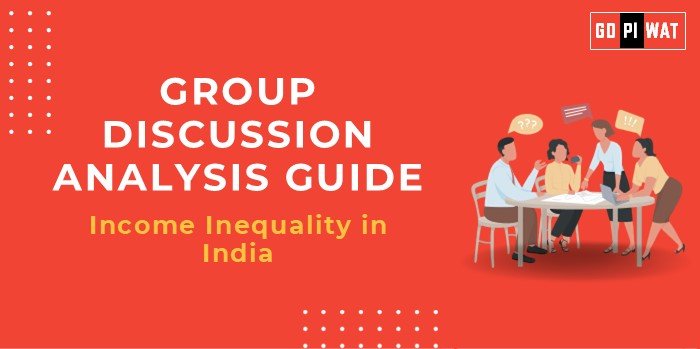📋 Group Discussion (GD) Analysis Guide
🌐 Introduction to Income Inequality in India
Income inequality in India has become a pressing issue in recent years, reflecting disparities in wealth distribution across urban and rural populations and different sectors of the economy. This topic holds significance for B-school students as it intersects with finance, public policy, and socio-economic development.
📖 Topic Background
The concept of income inequality measures the uneven distribution of income within a population. The Gini coefficient, a common metric used to assess inequality, has shown fluctuations for India in recent years. Historical factors like economic liberalization, globalization, and socio-economic disparities continue to shape the current landscape.
📊 Quick Facts and Key Statistics
- 📈 India’s Gini Coefficient: Approximately 0.35 in 2021, indicating a moderate level of income inequality. A Gini coefficient of 0.50 would suggest much higher inequality.
- 💰 Wealth Distribution: Top 10% of India’s population holds over 57% of the nation’s total income (2023).
- 🏘️ Urban-Rural Divide: Rural per capita income is roughly 50% of urban income.
- 🦠 COVID-19 Impact: Widened economic gaps, with the informal sector disproportionately affected.
- 👩🔧 Labor Force Participation: Women’s labor force participation remains below 30%, exacerbating economic disparities.
👥 Stakeholders and Their Roles
- 🏛️ Government and Policy Makers: Implement schemes and policies to promote equitable growth, such as social welfare programs and taxation reforms.
- 🏢 Private Sector and Corporations: Contribute to inclusive growth through employment opportunities, CSR initiatives, and ethical pay practices.
- 🙋♂️ Citizens and Civil Society: Advocate for fair wages, labor rights, and equitable access to resources.
- 🌍 International Organizations: Provide recommendations, financial aid, and policy guidelines to address inequality issues.
🎯 Achievements and Challenges
✨ Achievements
- 📉 Poverty Reduction: Significant decrease in absolute poverty due to targeted government programs (e.g., PM-Kisan, MGNREGA).
- 👨👩👧👦 Growth in Middle Class: Expansion of India’s middle class, creating a consumption-driven economy.
- 🌐 Digital Inclusion: Initiatives like Digital India have improved access to financial services for underserved communities.
⚠️ Challenges
- 🏡 Rural-Urban Disparity: Major income gap persists, with rural areas lagging in growth and employment opportunities.
- 📉 Jobless Growth: Economic growth has not translated into widespread employment gains.
- 👩💼 Gender Inequality: Persistent gender wage gap and lower labor force participation among women.
- 🌍 Global Comparisons: Countries like Norway and Denmark exhibit much lower inequality levels due to extensive social welfare systems.
📑 Structured Arguments for Discussion
✅ Supporting Stance
“India’s growth story masks an alarming rise in income inequality, as evident by the wealth concentration within a small elite.”
❌ Opposing Stance
“Government initiatives aimed at poverty reduction and social welfare have bridged economic gaps, reducing the severity of income inequality.”
⚖️ Balanced Perspective
“While economic policies have lifted millions from poverty, wealth distribution remains skewed, warranting targeted reforms for inclusive growth.”
💡 Effective Discussion Approaches
🔍 Opening Approaches
- 📊 Statistical Insight: “The top 1% of India’s population controls over 40% of national wealth, reflecting stark inequality despite economic growth.”
- 📉 Contrasting Example: “While India’s GDP growth rate averages 6-7%, rural income growth remains sluggish, illustrating the uneven benefits of development.”
🛡️ Counter-Argument Handling
- Acknowledge progress in poverty alleviation efforts.
- Present data-driven examples to highlight continued disparity.
- Advocate for policy measures like progressive taxation and social welfare programs.
📈 Strategic Analysis of Strengths and Weaknesses
Strengths: Large young workforce, strong GDP growth rates.
Weaknesses: High rural-urban income gap, insufficient social security nets.
Opportunities: Digital economy expansion, policy reforms for equitable growth.
Threats: Rising wealth concentration, slow employment generation.
🎓 Connecting with B-School Applications
💼 Real-World Applications
Suitable for projects on socio-economic policy, financial inclusion, or developmental economics.
❓ Sample Interview Questions
- “What role do government welfare schemes play in reducing income inequality in India?”
- “How can corporate initiatives help bridge income disparities in India?”
📘 Insights for B-School Students
Explore inclusive business models, study case studies on poverty alleviation, and examine global benchmarks.


